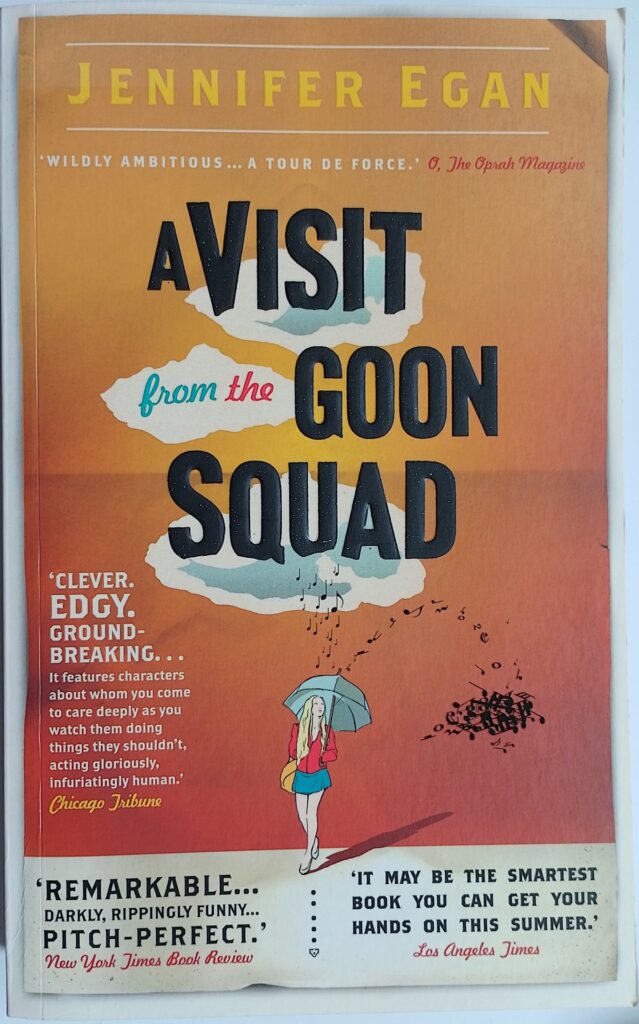First published 2010. Corsair, paperback, 2011, pp 336, c.80,000 words.
Nice title, but what does it mean? I had visions of someone powerful who had become upset and has sent his goons round to teach the miscreant a lesson. Wrong. Some way into this book it is explained that ‘time is a goon’ [p127]. Then this is a book on the consequence of time on the characters. It is structured as a set of thirteen stories, all of which relate in some way to two main characters: a popular music producer and his sometime assistant, which take place at various times from the 1970s through to the near future, presented in a non-linear fashion. Many of these stories were apparently previously published separately elsewhere, and they can be read as standalone pieces. However, the cumulative effect of what we learn about the characters and their associates means this adds up to more than just a collection of stories and form it into a novel. They are very amusingly written, and one laughs and cringes at the self-destructive lives of her well drawn characters.
This is the small world of the American pop music scene, with the middle-class values of New York and California. Drug abuse is quite normal, sex is frequently on the mind. Alcohol and cigarettes are commonplace. However these things cycle around, and in one of the last stories a young person is described as being ‘clean’, i.e. having no tattoos, having witnessed several previous generations’ tattoos sagging with aging bodies (although one can’t help feeling that a ‘clean’ body will eventually sag unappealingly too.)
Egan occasionally has a great turn of phrase and is acutely observant. Apart from ‘time is a goon’, for example, I also admired: ‘folding up his desire until it disappears’ [p207], ‘his awe at the gymnastic adaptability of the human mind, it also made him feel as though his wife had been brainwashed. By him.’ [p208], and ‘how had “American” become an ironic term? How had “democracy” come to be used in and arch, mocking way?’ [p320] – and that written long before the Trump presidency. A prosecutor is named ‘Atticus Levi’ [p180]. The sentence ‘When an über-powerful producer tried to manoeuvre her into bed, she’d called his wife.’ [p144] was written long before the Harvey Weinstein prosecution and the ‘Me Too’ movement. She observes: ‘…may be a crowd at a particular moment in history creates the object to justify the gathering…’ e.g. the Woodstock music festival [p331]. And that ‘…more people claim it [being there] than could have possibly have fitted inside the space…’ [p322]. This is also observed in a different form when an A-list party goes disastrously wrong and many guest suffer burns, whereupon others deliberately maim themselves so that they can claim to have been there, and therefore on the highly-desirable invite list.
The writing is elegant, fluid, and mostly easy to read. I only spotted ‘descrying’ (p333) as a word not in common spoken usage. One of the stories is written entirely as a PowerPoint presentation, and by a twelve-year-old girl. It is very clever, bringing out the thoughts of the girl and the relationships inside her nuclear family. However I hated it, and kept looking forward a few pages to see how soon it would end. I would much rather it had been written in the style of the rest of the book. I can see pretentious literati swooning over it though.
This is a very amusing read, (mostly) very well written and acutely observant of the limited milieu with which it deals.
Oh yes, she writes ‘…sealed inside his glutinous chair that for anyone else would have qualified as a couch.’ [p129] – so much more elegantly expressed than the same idea in Percy’s The Ninth Metal (2021).
© William John Graham, September 2022

